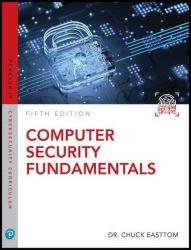Computer Security Fundamentals, Fifth Edition (Final)
- Добавил: literator
- Дата: 20-01-2023, 07:10
- Комментариев: 0
 Название: Computer Security Fundamentals, Fifth Edition
Название: Computer Security Fundamentals, Fifth EditionАвтор: Dr. Chuck Easttom
Издательство: Pearson Education
Год: 2023
Страниц: 576
Язык: английский
Формат: epub
Размер: 29.3 MB
One-volume introduction to computer security.
- Clearly explains core concepts, terminology, challenges, technologies, and skills
- Covers today's latest attacks and countermeasures
- The perfect beginner's guide for anyone interested in a computer security career
This guide covers web attacks, hacking, spyware, network defense, security appliances, VPNs, password use, and much more. Its many tips and examples refl ect new industry trends and the state-of-the-art in both attacks and defense. Exercises, projects, and review questions in every chapter help you deepen your understanding and apply all youve learned.
This book is a guide for any computer-savvy person. This means system administrators who are not security experts and anyone who has a working knowledge of computers and wishes to know more about cybercrime and cyber terrorism could find this book useful. However, the core audience will be students who wish to take a first course in security but may not have a thorough background in computer networks. The book is in textbook format, making it ideal for introductory computer security courses that have no specific prerequisites. That lack of prerequisites means that people outside the normal computer science and computer information systems departments could also avail themselves of a course based on this book. This might be of particular interest to law enforcement officers, criminal justice majors, and even business majors with an interest in computer security.
As was previously mentioned, this book is intended as an introductory computer security book. In addition to the numerous footnotes, the appendixes will guide you to a plethora of additional resources. There are also review questions and practice exercises with every chapter. Appendix B provides the answers to the multiple choice questions for your review. Exercises and projects are intended to encourage you to explore, so answers will vary.
This book assumes that you are a competent computer user. That means you have used a computer at work and at home, are comfortable with email and web browsers, and know what words like RAM and USB mean. For instructors considering using this book as a textbook, students should have a basic understanding of PCs but need not have had formal computer courses. For this reason, the book includes a chapter on basic networking concepts to get those students up to speed. Those with more knowledge, such as system administrators, will find some chapters of more use than others. Feel free to simply skim any chapter that you feel is too elementary for you.
Contents at a Glance:
Introduction
1 Introduction to Computer Security
2 Networks and the Internet
3 Cyber Stalking, Fraud, and Abuse
4 Denial of Service Attacks
5 Malware
6 Techniques Used by Hackers
7 Industrial Espionage in Cyberspace
8 Encryption
9 Computer Security Technology
10 Security Policies
11 Network Scanning and Vulnerability Scanning
12 Cyber Terrorism and Information Warfare
13 Cyber Detective
14 Introduction to Forensics
15 Cybersecurity Engineering
Glossary
Appendix A: Resources
Appendix B: Answers to the Multiple Choice Questions
Index
Скачать Computer Security Fundamentals, Fifth Edition
[related-news] [/related-news]
Внимание
Уважаемый посетитель, Вы зашли на сайт как незарегистрированный пользователь.
Мы рекомендуем Вам зарегистрироваться либо войти на сайт под своим именем.
Уважаемый посетитель, Вы зашли на сайт как незарегистрированный пользователь.
Мы рекомендуем Вам зарегистрироваться либо войти на сайт под своим именем.
